Research Interests
See also my CV & List of publications and my talk list. For students interested in working with me, check my student projects page. If you want to get a sense of my other upcoming new projects, have a look at my observing page or the observations section of my CV, which has nicer formatting. However, those have fallen pretty far out of date since I started my faculty position. Below are brief summaries of some of my completed and ongoing projects, mostly in reverse chronological order.
|
 We found salt in Orion Source I's disk, which motivated some follow-up
searching.
We found salt in another 9 disks,
indicating that this phenomenon is reasonably common.
We found salt in Orion Source I's disk, which motivated some follow-up
searching.
We found salt in another 9 disks,
indicating that this phenomenon is reasonably common.
|
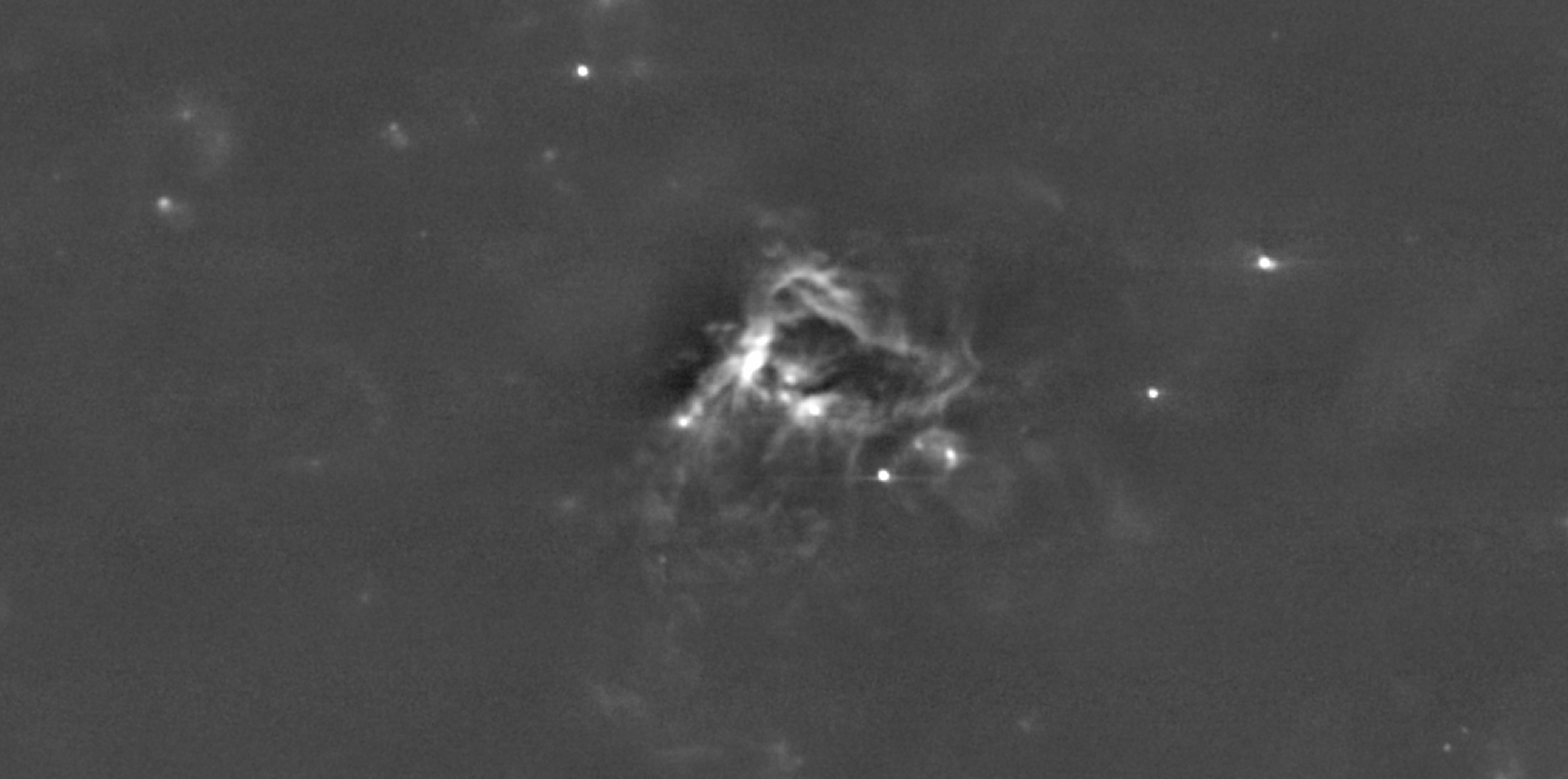 The MUSTANG Galactic
Plane Survey (MGPS) is creating the first 3mm continuum map of a large
fraction of the Galactic plane. With 10 arcsecond resolution and few
millijansky sensitivity, it can detect the youngest massive stars in the
Galaxy. This will be the first catalog of extremely young, accreting O/B stars
in our Galaxy. An early press release highlights the Galactic Center data. The first
paper describing the pilot fields has been published. We found that
the HCHII region lifetime is a substantial fraction - 10-50% - of the
UCHII region lifetime, though there are still very few isolated HCHII regions
known.
The MUSTANG Galactic
Plane Survey (MGPS) is creating the first 3mm continuum map of a large
fraction of the Galactic plane. With 10 arcsecond resolution and few
millijansky sensitivity, it can detect the youngest massive stars in the
Galaxy. This will be the first catalog of extremely young, accreting O/B stars
in our Galaxy. An early press release highlights the Galactic Center data. The first
paper describing the pilot fields has been published. We found that
the HCHII region lifetime is a substantial fraction - 10-50% - of the
UCHII region lifetime, though there are still very few isolated HCHII regions
known.
|
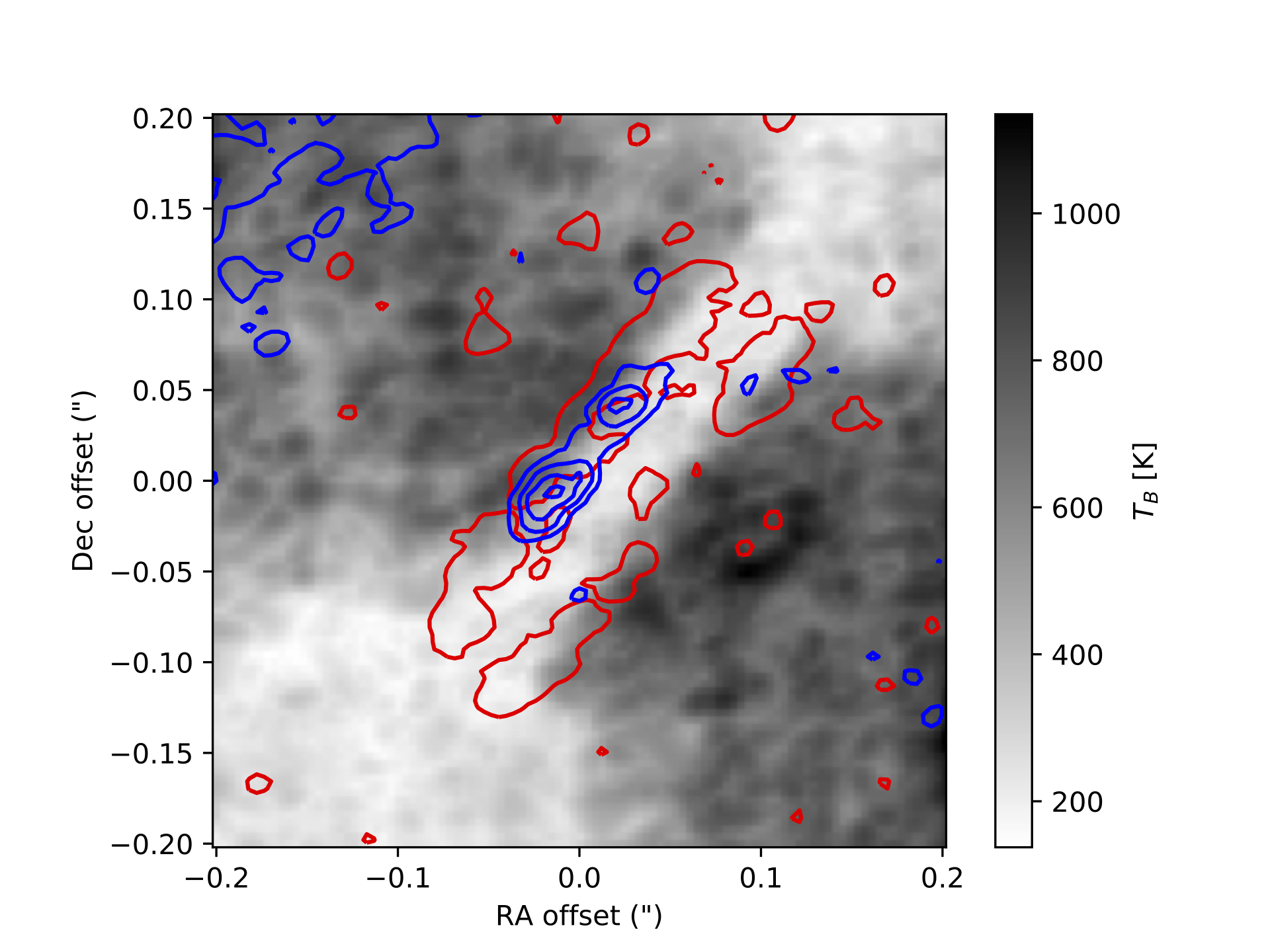 Orion's Source I is the closest forming high-mass protostar. We fit a Keplerian
rotation curve to the velocity profile of its disk to determine that the
central star is 15 M⊙ (source code for the project).
We found some previously unknown lines in this survey, and we've now identified
them as salts, NaCl and KCl. We published this result in
ApJ; the source repository is here.
Orion's Source I is the closest forming high-mass protostar. We fit a Keplerian
rotation curve to the velocity profile of its disk to determine that the
central star is 15 M⊙ (source code for the project).
We found some previously unknown lines in this survey, and we've now identified
them as salts, NaCl and KCl. We published this result in
ApJ; the source repository is here.
|
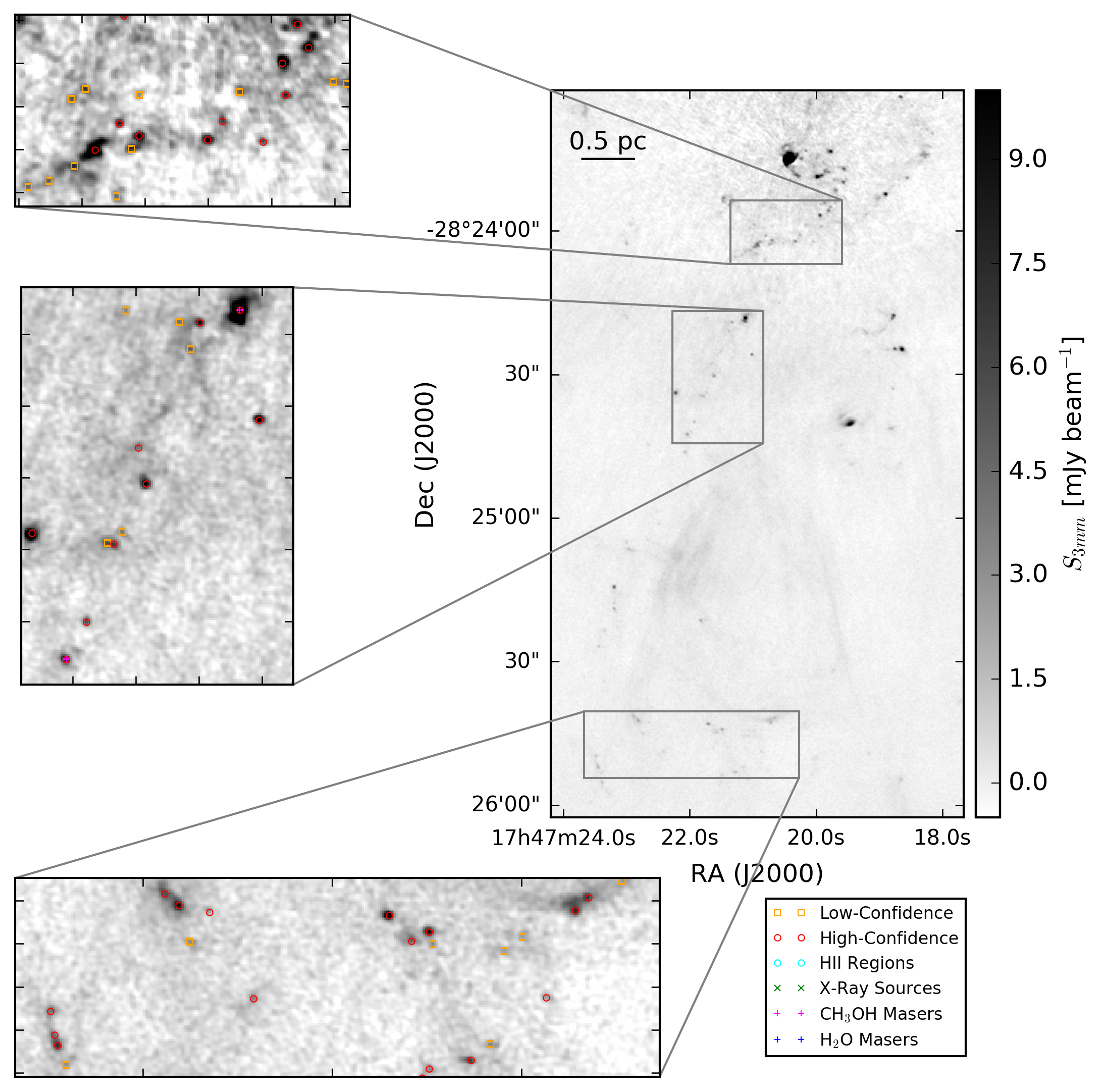 Sgr B2 is the most massive molecular cloud in the Galaxy and the most
actively star-forming cloud in the Galactic center. I led an ALMA project to survey the whole cloud. The paper is
available here.
Sgr B2 is the most massive molecular cloud in the Galaxy and the most
actively star-forming cloud in the Galactic center. I led an ALMA project to survey the whole cloud. The paper is
available here.
We found almost 300 sources in the 3 mm ALMA data, most of which were not previously known. They appear to all be high-mass YSOs of some sort. The Sgr B2 "Deep South" region, pictured on the right, is forming a population of YSOs as large as the Sgr B2 M and N protoclusters combined. These data show that the cluster formation efficiency is about 1/3, much higher than in the rest of the Galaxy. I have an ongoing ALMA program (2018.1.00057.S and 2017.1.00114.S) to measure the low-mass protostars in Sgr B2 DS. |
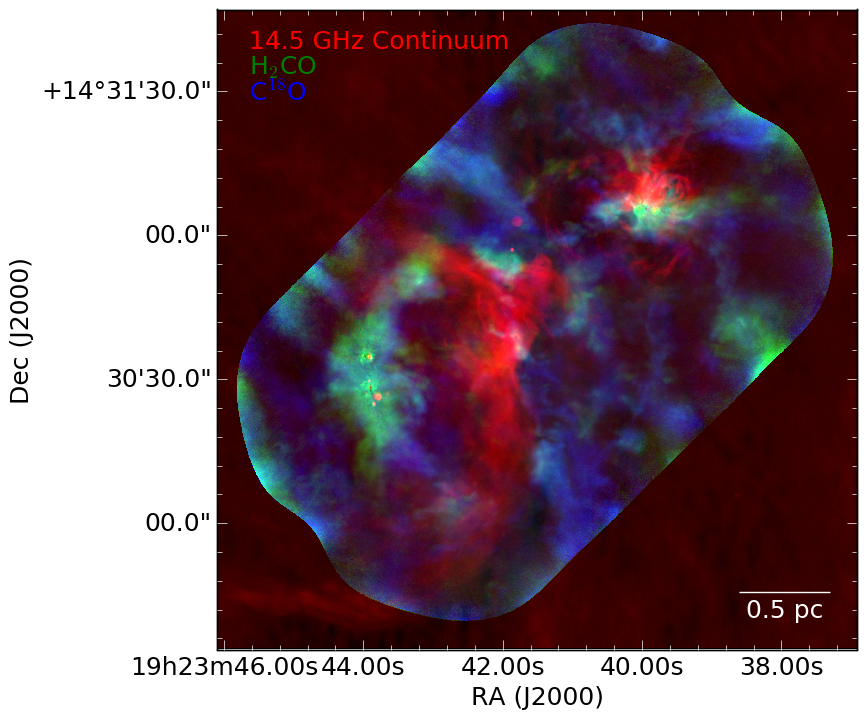
I led a series of programs with the VLA and ALMA to look at the ionized gas and the dense molecular gas in the W51 star forming region. The VLA project revealed the probable population of high-mass stars illuminating the HII region and demonstrated that gas exhaustion is the likely end state of the forming clusters. The ALMA project showed that the high-mass stars are forming in hot cores with temperatures >100 K out to radii of ~5000 AU. With such a large volume and mass of gas heated to high temperatures, it is likely that these stars effectively suppress fragmentation in their surroundings, cooking their food before they consume it. I wrote a review of the W51 cloud for the Star Formation Newsletter. I observed the high-mass YSOs in W51 with ALMA in program 2015.1.01596.S, and discovered that they have only small disks, less than a few hundred AU. We will measure the disk sizes more directly in ongoing program 2017.1.00293.S. |

The center few hundred parsecs of our Galaxy are filled with stars and gas, especially the dense molecular gas that forms stars. I led a large mapping project with the APEX telescope to use formaldehyde (H2CO) to measure the temperature of the dense, potentially star-forming gas in the whole CMZ. We found that gas temperatures are universally high in the densest gas, which makes this gas very different from the "normal" gas near our solar system. Usually, dense gas is very cold (<20 K), but in the CMZ is it warm (>50 K), so it must be heated more than "normal" gas. We concluded that the intense turbulence throughout CMZ gas is the most likely heat source. Cosmic ray heating has been ruled out, since a high cosmic ray ionization rate would result in a too-uniform heating rate. The data are publicly available. My other projects in the CMZ include an ALMA survey of Sgr B2, a survey of H2CO that revealed a unique maser, and an ongoing project combining the above data sets to measure star formation along the CMZ "ring". |
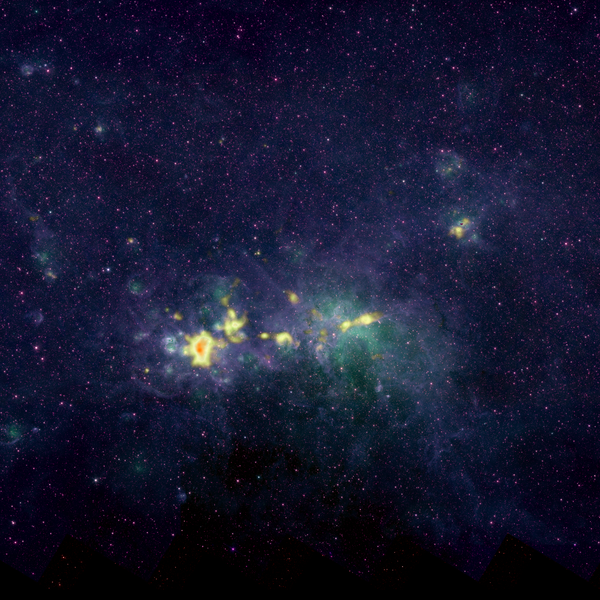
Densities in W51
W51 is the most
actively star-forming complex in the Galactic plane, containing two of
the most massive proto-clusters. I have led projects to map it in
formaldehyde with the GBT, the Arecibo observatory, and
the Very Large Array.
In the single-dish survey, we mapped the 6cm and 2cm spectral lines to create a parsec-resolution map of the volume density of the cloud. The volume density of gas - the number of particles per cubic centimeter - is very difficult to measure, but it is one of the fundamental quantities determining which gas will form into stars. We found that the volume density within the forming W51 proto-clusters is >105 cm-3, showing that these regions have most of their gas well above normal 'thresholds' for star formation. Data from this project are publicly available. |
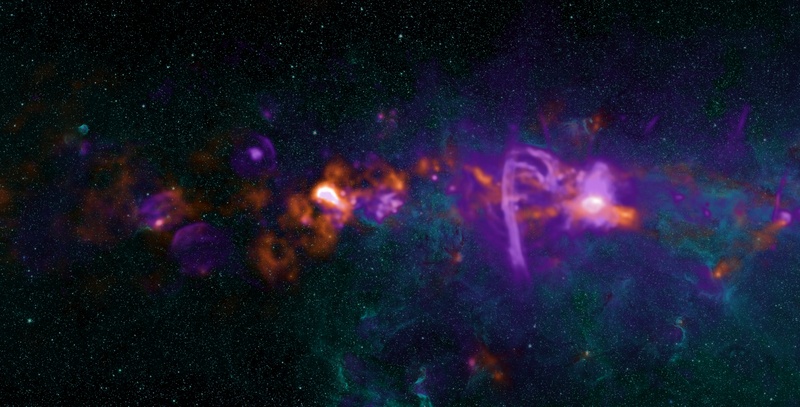
The Bolocam Galactic Plane Survey
I played an integral role in the
Bolocam Galactic Plane Survey.
The BGPS is a 1.1mm survey of the northern Galactic plane using the Bolocam
bolometer array on the Caltech Submillimeter Observatory (CSO) from
2005-2009. It was
released to the public via IPAC
in June 2009. I wrote the
data reduction pipeline
and reduced the data. I am a coauthor on 12 of the 13 papers from the survey, including 1st author on the
second data release 2nd author on the
data paper
and 3rd author on the
catalog paper. The image
to the right was the 2008 (and final) NRAO photo contest winner.
An early poster from AAS 215 is here.
|
| One of the first major results from the BGPS is that There are No Starless Massive Proto-clusters in the First Quadrant of the Galaxy. The lack of starless massive proto-clusters is not a surprising result in itself: such objects are expected to be rare, but this paper presents a measured upper limit on the rate of their formation (assuming massive proto-clusters experience a starless phase). However, it is rather surprising that we found nothing that was truly unknown in the first blind survey of the Galactic plane between 100 microns (IRAS) and 2 cm (Glen Langston's GPS). |
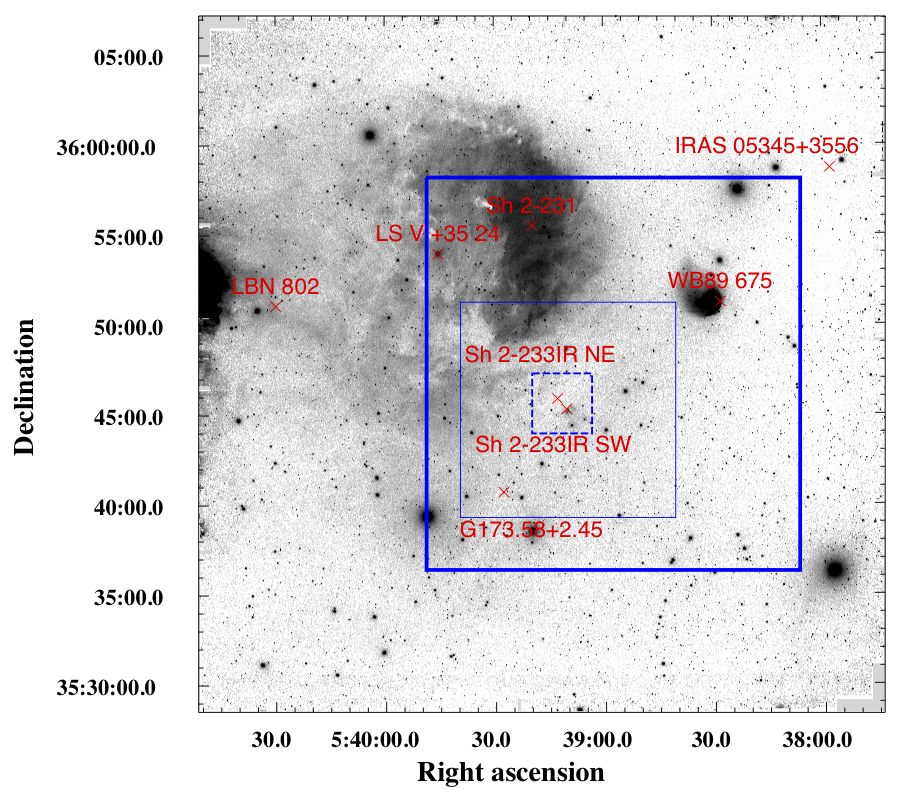
IRAS 05358+3543
My first accepted paper was a NIR/mm study of the high-mass star forming
region IRAS 05358+3543. We
identified additional outflows and suggested that there may be a ~10
MO binary in the system. At a distance of 1.7 kpc, this object
is one of the closest and best examples of a hypercompact HII region that
is likely to be a high-mass star still accreting. The paper was
published in the Astrophysical Journal.
I am a co-author on a near-infrared work by Chi-Hung Yan.
The CO data cubes are publicly available.
|
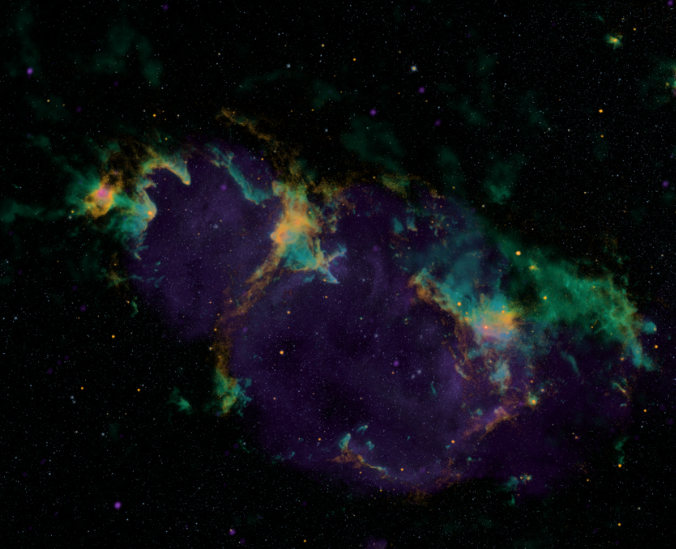
Outflows in W5 and L111
I have studied the W5 and L111 massive star forming complexes in the outer
galaxy using the James Clerk Maxwell Telescope's HARP heterodyne array and
the Bolocam Galactic Plane Survey. We discovered many outflows
and determined that star formation is occurring in parts of these regions
previously suspected to be inactive. The reduced W5 data
are publicly available.
Some of this research was presented at the Stars to Galaxies conference in this poster and these proceedings, and other components at the Protostellar Jets in Context conference. |
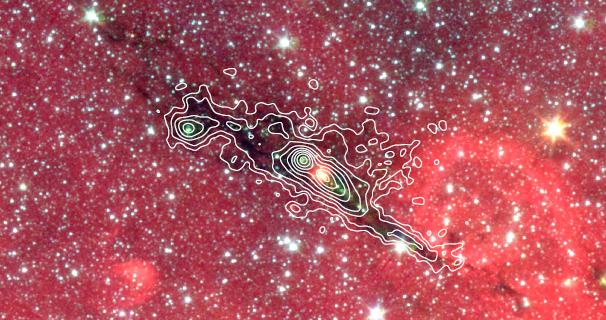
IRDCs
I collaborated on a project led by Cara Battersby
to study the physical properties of Infrared Dark Clouds (IRDCs).
The first publication
is a detailed study of a few clumps using millimeter continuum and
heterodyne data in conjunction with VLA continuum data to evaluate
evolutionary states. A second publication
on the non-IR-dark cousins of IRDCs using Herschel data has also been
completed.
We have followed up these works with NH3 observations in
The Comparison of Physical Properties Derived from Gas and Dust in a Massive Star-forming Region
and The Onset of Massive Star Formation: The Evolution of Temperature and Density Structure in an Infrared Dark Cloud.
Further work
with Ke Wang has been featured in
press releases.
|
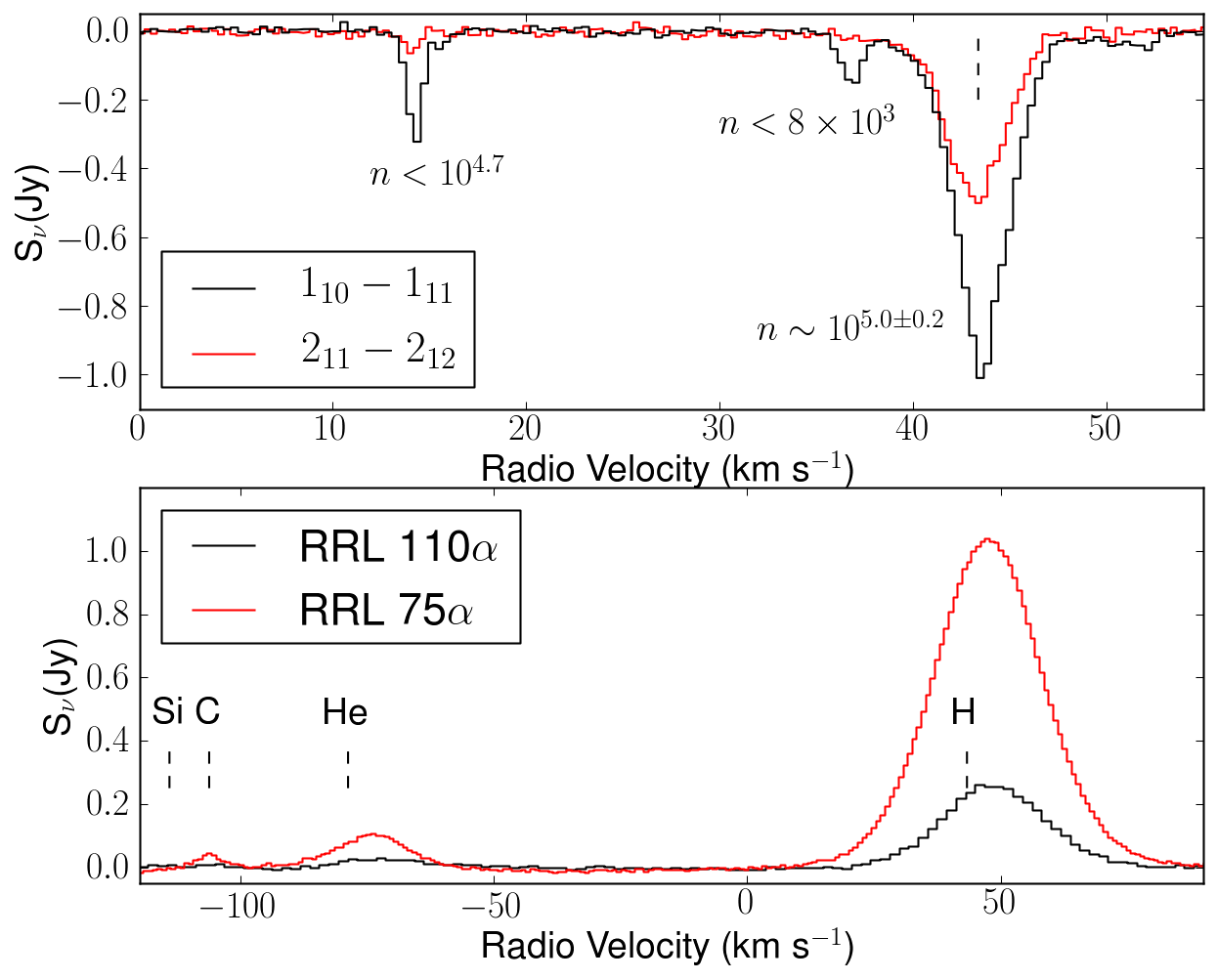
H2CO
I led a study of the density of molecular "clumps" in the Galactic plane using the
formaldehyde densitometer
with collaborators
Cara Battersby,
Jeremy Darling,
and Ben Zeiger.
Our pilot program
is completed and the main survey is complete. The first results were
presented at AAS 217 in Seattle. The rest of the data are reduced, but no
publications are presently in preparation; please let me know if you're
interested in collaborating.
The formaldehyde survey lead to the realization that turbulence plays a major role in the observed line strength for molecular species with a strong density sensitivity. "High-density tracers" may be excited even in "low-density" gas because of the presence of a tail of high-density gas. A detailed analysis of this process allowed us to make a measurement of the turbulence-driven density distribution in a molecular cloud. |
![A coronagraphic image of P Cygni taken in the 1.644 micron [Fe II] filter using NICFPS at the Apache Point Observatory](images/pcyg_highcontrast.png)
LBVs
I like studying Luminous Blue Variable stars and their ejecta. However, I
don't do much with them professionally at the moment.
The image shown here is a demonstration of the capabilities of a moderate aperture 3.5m telescope in imaging circumstellar ejecta. A simple coronagraph - a thin sheet of metal - was put at the focus of the NICFPS imaging system to acquire this image, which shows two concentric explosions from the eruptive LBV P Cygni. |
|
Software Development
I am interested in software development for public use. My
personal software page lists some of my
projects, but more can be found at my github page.
|
|
Some other stuff I've done: Spitzer, 2MASS, UBVi Filter Specifications / Spectral Responses / Zero Magnitude Fluxes Observing Record |